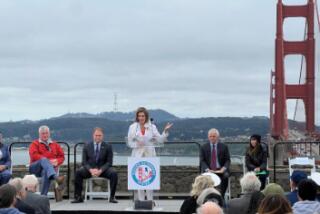Golden Gate Bridge gets $76 million for suicide prevention nets
- Share via
San Francisco Bay Area officials on Friday approved a $76-million package to fund suicide prevention nets that will extend 20 feet on either side of the Golden Gate Bridge, handing a victory to advocates who have long pushed to hem in the 1.7-mile long span against suicidal jumpers.
Since the rust-colored bridge opened in 1937, an estimated 1,600 people have plunged to their deaths, officials said. Of that total, a record 46 suicides were recorded last year and more than 100 other would-be jumpers were stopped by bridge workers.
Kevin Hines, one of a only a handful of people known to have survived a jump from the Golden Gate Bridge, lauded the plan in a statement issued prior to the vote.
“We are finally showing the rest of the world that San Francisco can be as progressive as it claims to be,” he said.
Advocates of the netting say it will prevent jumpers from hurling themselves to their deaths, and possibly act as a deterrent. Opponents of the plan have said the project won’t prevent people from finding alternative ways of committing suicide off the iconic bridge.
The board of directors for the Golden Gate Bridge, Highway and Transportation District, which voted unanimously in favor of the funding package for the nets, had previously rejected raising the bridge’s 4-foot-high railings.
At its highest point, the bridge stands 220 feet above the San Francisco Bay.
To construct the stainless steel net system, rolling scaffolds used by maintenance workers under the bridge will be replaced because the project will block the equipment.
A separate $8-million wind retrofit project will also be combined with the netting to avoid delays from construction. Crews will then install a horizontal net system that extends 20 feet from below the sidewalks.
Funding for the project will come from a mix of federal and state money, as well as proceeds from bridge tolls. Federal funding became available for the project through a bill signed by President Obama two years ago.
For breaking news in Los Angeles and the Southland, follow @Caitlin__Owens, or email her at caitlin.owens@latimes.com.
More to Read
Sign up for Essential California
The most important California stories and recommendations in your inbox every morning.
You may occasionally receive promotional content from the Los Angeles Times.













